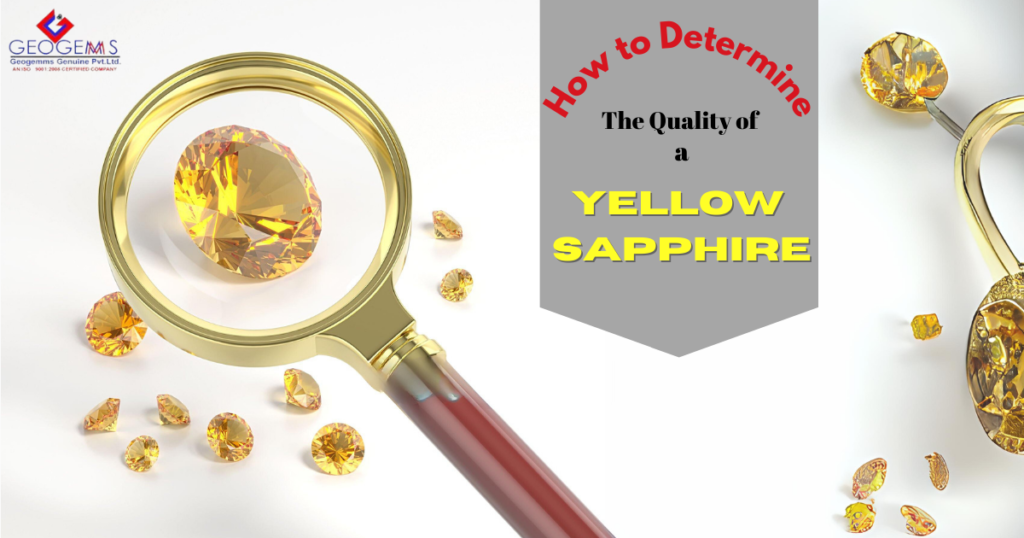Celebration
How to Determine the Quality of a Yellow Sapphire
Yellow sapphires, known for their radiant hues and stunning clarity, are highly prized gems in the world of fine jewelry. However, for many, determining the quality of a yellow sapphire can be a bit tricky. Let’s explore the key factors to consider when assessing the quality of yellow sapphire, ensuring you make an informed and confident purchase.
Color of Yellow Sapphire
Color is the most critical factor in determining the quality of a yellow sapphire. The finest yellow sapphires display a vivid, bright yellow hue without any brown or green tints. The most desirable color is often referred to as a “canary” yellow, similar to the vibrant color of a canary bird. When evaluating color, consider three main aspects: hue, tone, and saturation. The hue is the dominant color of the sapphire, and the ideal yellow sapphire should have a pure, rich yellow hue.
The tone refers to the depth of the color, ranging from light to dark, with the best quality yellow sapphires having a medium to medium-dark tone. Saturation indicates the intensity or purity of the color, with high saturation, vivid, and intense yellow being most prized.
Clarity of Yellow Sapphire
Clarity refers to the presence of internal or external imperfections, known as inclusions and blemishes, respectively. While most sapphires contain some inclusions, the best quality yellow sapphires are those with minimal visible inclusions to the naked eye.
Eye-clean sapphires, a term used to describe sapphires with no visible inclusions when viewed without magnification, are considered high quality. Some inclusions are more acceptable than others; for instance, rutile needles (also known as silk) are common in sapphires and can enhance the gem’s overall appearance if they are not too dense. Thus, while inclusions are a natural part of sapphires, their type and visibility significantly affect the gem’s quality.
Cut of Yellow Sapphire
Cut affects the brilliance and overall appearance of the yellow sapphire. A well-cut sapphire will reflect light beautifully, enhancing its color and sparkle. When evaluating the cut, pay attention to proportions, symmetry, and polish. Proportions refer to the balance between the depth and width of the gem, with proper proportions ensuring maximum light reflection.
Symmetry involves the alignment of the facets, with symmetrical sapphires having better light performance. Polish refers to the smoothness of the sapphire’s surface, with a high-quality polish ensuring that the gem is free of scratches and abrasions. A well-executed cut can significantly enhance a yellow sapphire’s visual appeal and value.
Carat Weight of Yellow Sapphire
Carat weight refers to the size of the sapphire. While larger yellow sapphires are rarer and more valuable, the overall quality is a combination of size and the other factors (color, clarity, and cut). When comparing sapphires of similar quality, a higher carat weight typically means a higher price.
However, it’s essential to balance carat weight with the other quality factors, as a larger stone with poor color or clarity will not be as valuable or beautiful as a smaller stone with excellent attributes. Therefore, while size matters, it should be considered alongside the other critical quality factors.
Origin of Yellow Sapphire
The origin of a yellow sapphire can also influence its value. Certain locations are renowned for producing high-quality sapphires. Sri Lanka (Ceylon) is known for producing some of the finest yellow sapphires with exceptional clarity and color. Madagascar is another prominent source, known for its vibrant and high-quality sapphires.
Thailand and Australia also produce yellow sapphires, but they may not always reach the same level of quality as those from Sri Lanka or Madagascar. The origin can often give insights into the sapphire’s overall quality and characteristics, making it an important factor to consider.
Treatments of Yellow Sapphire
Many yellow sapphires undergo treatments to enhance their color and clarity. Common treatments include heat treatment and diffusion treatment. Heat treatment is used to improve color and clarity and is widely accepted in the market, but untreated sapphires are rarer and more valuable.
Diffusion treatment involves adding color to the sapphire’s surface and diffusion-treated sapphires are less valuable and should be disclosed by the seller. Understanding these treatments and their impact on the sapphire’s value and appearance is crucial when evaluating a yellow sapphire.
Conclusion
Determining the quality of a yellow sapphire involves a careful evaluation of its color, clarity, cut, carat weight, origin, and any treatments it may have undergone. By understanding these factors, you can make an informed decision and choose a yellow sapphire that not only meets your aesthetic preferences but also holds its value over time. When in doubt, consulting with a certified gemologist or purchasing from a reputable jeweler can provide additional assurance of the gem’s quality. Ensuring you have a comprehensive understanding of these factors will help you select a beautiful and valuable yellow sapphire that you can cherish for years to come.

